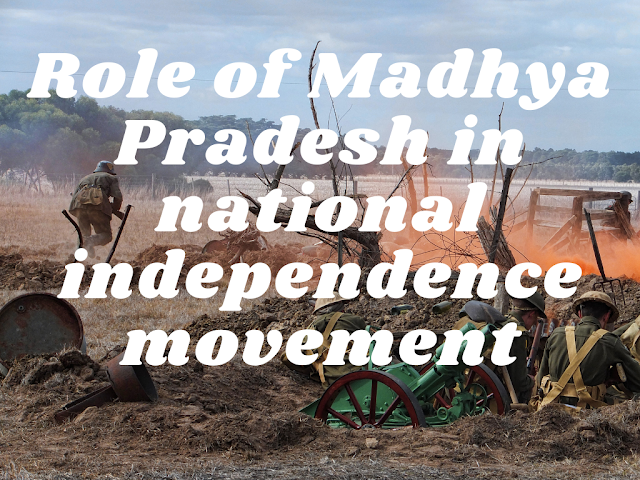Role of Madhya Pradesh in national independence movement
Khilafat / Non-Cooperation Movement in Madhya Pradesh 1919 and 1920, Flag Satyagraha in Madhya Pradesh 1923, Civil Disobedience Movement 1930, Madhya Pradesh: - Charan Paduka Massacre 1931, Madhya Pradesh: Quit India Movement Madhya Pradesh:
for Hindi version - click here
The people of Madhya Pradesh participated actively in the national independent movement. Political activities in Madhya Pradesh started from 1906 AD. In 1906, the provincial session of Madhya Pradesh was held in Jabalpur in which Pandit Ravi Shankar Shukla Raghavendra Singh of Madhya Pradesh, Dr. Singh Gaur etc. Leaders joined further. The Revolutionary Party was formed in Jabalpur in 1907, in 1915 the Homerule League was established in Jabalpur itself.
Khilafat and Non-Cooperation Movement in Madhya Pradesh 1919 and 1920: -
The movement started in Seoni district in Madhya Pradesh, in which the non-cooperation of the Congress and the Khilafat Movement took the form of cooperation and the Khilafat Movement in Madhya Pradesh was led by Prabhakar Pari Raj Yadav and Abdul Ghaffar Khan respectively.
#Flag Satyagraha in Madhya Pradesh 1923: -
The Jabalpur District Congress Committee hoisted the tricolor in Jabalpur Town Hall in honor of Ajmal Khan, who was visiting Jabalpur in preparation for the Non-Cooperation Movement in March 1923, but was flagged off at the behest of the British Deputy Commissioner. In protest, Congress leader Pandit Sundarlal Sharma Subhadra Kumari Chauhan Laxman Singh Chauhan Narhari Agarwal Nathuram Modi, etc. took out a procession but these leaders were arrested by the police. Pandit Sundarlal Sharma was given 6 months imprisonment.
Realizing the importance of the Satyagraha, the Congress chose Nagpur to start it at the all-India level, where preparations were made under the leadership of Jamnalal Bajaj. Once the Satyagraha started in Pune, Jabalpur, Sarojini Naidu and Maulana Abul Kalam Azad. In the presence Kanchedilal Bansi Lal and Kashi Prasad hoisted the flag again in Jabalpur Town Hall, the three were given three months imprisonment. In Nagpur, Satyagrahis also succeeded in hoisting the flag and the All India Working Committee of the Congress on 9 July 1923. On the meeting, the flag Satyagraha was approved and in this movement, leaders like Sarojini Naidu on Sardar Vallabhbhai Patel came and participated in Nagpur, thus the Satyagraha started from Jabalpur was soon dedicated to All India importance.
Civil Disobedience Movement 1930 Madhya Pradesh: -
On April 6, 1930, as soon as Gandhiji's Dandi March ended, Salt Satyagraha started in various places of Madhya Pradesh from April 7, under the leadership of Seth Govind Das and Pandit Dwarka Prasad Mishra at the Samadhi of Rani Durgavati located in Barela near Jabalpur. And under the leadership of Durgadas Mehta of Seoni district, the Salt Satyagraha started, in addition to this the salt law was broken in Khandwa Sehore Mandla etc.
At the time of the Civil Disobedience Movement, the tribals in the Seoni and Betul districts of Madhya Pradesh started the Van Satyagraha, under the Van Satyagraha, the tribals came out of the jungles of Madhya Pradesh with a blanket on their shoulders and sticks in their hands in the horse riding area. Wait for Singh, he struggled with the British for a long time against the laws of forests, gave up his life for freedom, in the same way, the Toria region Shivani tribals also opposed the forest laws, started the Satyagraha, here four tribes became martyrs, thus Satyagraha here Was crushed with power.
Charan Paduka Massacre 1931 in Madhya Pradesh: -
In Charan Paduka village of Chhatarpur district, the police opened fire on a peaceful meeting of freedom fighters in which many people lost their lives and this incident is also known as the Jallianwala Bagh massacre of Madhya Pradesh.
Quit India Movement in Madhya Pradesh: -
The Quit India Movement of 1942 started in Vidisha in the state of Gwalior in Madhya Pradesh and soon spread throughout Madhya Pradesh, this movement was the first in backward districts like Dhar Jhabua. During this movement, many underground leaders in the Malwa region of Ratlam, Indranarayan Puranic Malini Sarwate Indu Patkar and Johari Lal, arrested the police, Jelly and Padmadhar Singh of Satna district martyred with the police bullet. During this movement, arrest was also made.
In this way, the people of Madhya Pradesh contributed significantly to the national independence movement.The tribals of Madhya Pradesh too, shoulder to shoulder, forced the British to leave India. In fact, in the national movement, the people of Madhya Pradesh and other provinces also fought for freedom. Sacrificed the result of which India attained independence on 15 August 1947!





![[ MP GK*]मध्यप्रदेश के पड़ोसी राज्य तथा उनसे लगे मध्यप्रदेश के जिले- The neighboring states of Madhya Pradesh and the districts of Madhya Pradesh adjoining them-](https://1.bp.blogspot.com/-xvjS9uq1s9o/YMmi0kedNQI/AAAAAAAALac/cfndotXYoPETNkzc6Wzd4k-VcO1XjWyIgCLcBGAsYHQ/w100/%25E0%25A4%25AE%25E0%25A4%25A7%25E0%25A5%258D%25E0%25A4%25AF%25E0%25A4%25AA%25E0%25A5%258D%25E0%25A4%25B0%25E0%25A4%25A6%25E0%25A5%2587%25E0%25A4%25B6%2B%25E0%25A4%2595%25E0%25A5%2587%2B%25E0%25A4%25AA%25E0%25A4%25A1%25E0%25A4%25BC%25E0%25A5%258B%25E0%25A4%25B8%25E0%25A5%2580%2B%25E0%25A4%25B0%25E0%25A4%25BE%25E0%25A4%259C%25E0%25A5%258D%25E0%25A4%25AF%2B%25E0%25A4%25A4%25E0%25A4%25A5%25E0%25A4%25BE%2B%25E0%25A4%2589%25E0%25A4%25A8%25E0%25A4%25B8%25E0%25A5%2587%2B%25E0%25A4%25B2%25E0%25A4%2597%25E0%25A5%2587%2B%25E0%25A4%25AE%25E0%25A4%25A7%25E0%25A5%258D%25E0%25A4%25AF%25E0%25A4%25AA%25E0%25A5%258D%25E0%25A4%25B0%25E0%25A4%25A6%25E0%25A5%2587%25E0%25A4%25B6%2B%25E0%25A4%2595%25E0%25A5%2587%2B%25E0%25A4%259C%25E0%25A4%25BF%25E0%25A4%25B2%25E0%25A5%2587.jpg)
![[MP GK*]प्रोजेक्ट टाइगर में सम्मिलित मध्य प्रदेश के राष्ट्रीय उद्यान एवं अभ्यारण](https://1.bp.blogspot.com/--evhdsVs19g/YGQk4cU08AI/AAAAAAAAKgw/whD4YvPgFXEtUxg10P7jzLAtFcO8pO49QCLcBGAsYHQ/w100/%25E0%25A4%25AA%25E0%25A5%258D%25E0%25A4%25B0%25E0%25A5%258B%25E0%25A4%259C%25E0%25A5%2587%25E0%25A4%2595%25E0%25A5%258D%25E0%25A4%259F%2B%25E0%25A4%259F%25E0%25A4%25BE%25E0%25A4%2587%25E0%25A4%2597%25E0%25A4%25B0%2B%25E0%25A4%25AE%25E0%25A5%2587%25E0%25A4%2582%2B%25E0%25A4%25B8%25E0%25A4%25AE%25E0%25A5%258D%25E0%25A4%25AE%25E0%25A4%25BF%25E0%25A4%25B2%25E0%25A4%25BF%25E0%25A4%25A4%2B%25E0%25A4%25AE%25E0%25A4%25A7%25E0%25A5%258D%25E0%25A4%25AF%2B%25E0%25A4%25AA%25E0%25A5%258D%25E0%25A4%25B0%25E0%25A4%25A6%25E0%25A5%2587%25E0%25A4%25B6%2B%25E0%25A4%2595%25E0%25A5%2587%2B%25E0%25A4%25B0%25E0%25A4%25BE%25E0%25A4%25B7%25E0%25A5%258D%25E0%25A4%259F%25E0%25A5%258D%25E0%25A4%25B0%25E0%25A5%2580%25E0%25A4%25AF%2B%25E0%25A4%2589%25E0%25A4%25A6%25E0%25A5%258D%25E0%25A4%25AF%25E0%25A4%25BE%25E0%25A4%25A8%2B%25E0%25A4%258F%25E0%25A4%25B5%25E0%25A4%2582%2B%25E0%25A4%2585%25E0%25A4%25AD%25E0%25A5%258D%25E0%25A4%25AF%25E0%25A4%25BE%25E0%25A4%25B0%25E0%25A4%25A3.jpg)
![[MP GK*] Chhindwara District MP GK in Hindi - छिंदवाड़ा जिला - मध्य प्रदेश सामान्य ज्ञान](https://1.bp.blogspot.com/-fqPLsI6cK7M/YMhYR0ACanI/AAAAAAAALaM/yJE_HeYTNx8FiY36eUeKEMtVOh09wkm3QCLcBGAsYHQ/w100/%25E0%25A4%25B8%25E0%25A4%25A4%25E0%25A4%25A8%25E0%25A4%25BE%2B%25E0%25A4%259C%25E0%25A4%25BF%25E0%25A4%25B2%25E0%25A4%25BE%2B-%2B%25E0%25A4%25AE%25E0%25A4%25A7%25E0%25A5%258D%25E0%25A4%25AF%2B%25E0%25A4%25AA%25E0%25A5%258D%25E0%25A4%25B0%25E0%25A4%25A6%25E0%25A5%2587%25E0%25A4%25B6%2B%25E0%25A4%25B8%25E0%25A4%25BE%25E0%25A4%25AE%25E0%25A4%25BE%25E0%25A4%25A8%25E0%25A5%258D%25E0%25A4%25AF%2B%25E0%25A4%259C%25E0%25A5%258D%25E0%25A4%259E%25E0%25A4%25BE%25E0%25A4%25A8%2B%25281%2529.jpg)